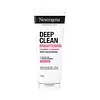Neutrogena Pink Grapefruit Oil-Free Acne Wash Versus Neutrogena Deep Clean Brightening Foaming Cleanser
What's inside
What's inside
 Key Ingredients
Key Ingredients

 Benefits
Benefits

 Concerns
Concerns

 Ingredients Side-by-side
Ingredients Side-by-side

Salicylic Acid 2%
MaskingWater
Skin ConditioningSodium C14-16 Olefin Sulfonate
CleansingCocamidopropyl Betaine
CleansingSodium Chloride
MaskingPEG-120 Methyl Glucose Dioleate
EmulsifyingPolysorbate 20
EmulsifyingLinoleamidopropyl Pg-Dimonium Chloride Phosphate
Propylene Glycol
HumectantPEG-80 Sorbitan Laurate
Parfum
MaskingDisodium EDTA
Benzalkonium Chloride
AntimicrobialC12-15 Alkyl Lactate
EmollientPolyquaternium-7
Sodium Benzotriazolyl Butylphenol Sulfonate
UV AbsorberCocamidopropyl Pg-Dimonium Chloride Phosphate
Ascorbyl Palmitate
AntioxidantAloe Barbadensis Leaf Extract
EmollientAnthemis Nobilis Flower Extract
MaskingChamomilla Recutita Flower Extract
MaskingCitrus Grandis Fruit Extract
AstringentCitric Acid
BufferingSodium Hydroxide
BufferingCI 16035
Cosmetic ColorantCI 60725
Cosmetic ColorantSalicylic Acid 2%, Water, Sodium C14-16 Olefin Sulfonate, Cocamidopropyl Betaine, Sodium Chloride, PEG-120 Methyl Glucose Dioleate, Polysorbate 20, Linoleamidopropyl Pg-Dimonium Chloride Phosphate, Propylene Glycol, PEG-80 Sorbitan Laurate, Parfum, Disodium EDTA, Benzalkonium Chloride, C12-15 Alkyl Lactate, Polyquaternium-7, Sodium Benzotriazolyl Butylphenol Sulfonate, Cocamidopropyl Pg-Dimonium Chloride Phosphate, Ascorbyl Palmitate, Aloe Barbadensis Leaf Extract, Anthemis Nobilis Flower Extract, Chamomilla Recutita Flower Extract, Citrus Grandis Fruit Extract, Citric Acid, Sodium Hydroxide, CI 16035, CI 60725
Water
Skin ConditioningGlycerin
HumectantSodium Cocoyl Glycinate
CleansingSodium Cocoyl Isethionate
CleansingCocamidopropyl Betaine
CleansingMyristic Acid
CleansingGlycol Distearate
EmollientAcrylates Copolymer
Niacinamide
SmoothingLauric Acid
CleansingPEG-120 Methyl Glucose Dioleate
EmulsifyingPhenoxyethanol
PreservativeCaprylyl Glycol
EmollientParfum
MaskingChlorphenesin
AntimicrobialSodium Hydroxide
BufferingHydroxyethylcellulose
Emulsion StabilisingDisodium EDTA
Water, Glycerin, Sodium Cocoyl Glycinate, Sodium Cocoyl Isethionate, Cocamidopropyl Betaine, Myristic Acid, Glycol Distearate, Acrylates Copolymer, Niacinamide, Lauric Acid, PEG-120 Methyl Glucose Dioleate, Phenoxyethanol, Caprylyl Glycol, Parfum, Chlorphenesin, Sodium Hydroxide, Hydroxyethylcellulose, Disodium EDTA
 Reviews
Reviews

Ingredients Explained
These ingredients are found in both products.
Ingredients higher up in an ingredient list are typically present in a larger amount.
Cocamidopropyl Betaine is a fatty acid created by mixing similar compounds in coconut oil and dimethylaminopropylamine, a compound with two amino groups.
This ingredient is a surfactant and cleanser. It helps gather the dirt, pollutants, and other impurities in your skin to be washed away. It also helps thicken a product and make the texture more creamy.
Being created from coconut oil means Cocamidopropyl Betaine is hydrating for the skin.
While Cocamidopropyl Betaine was believed to be an allergen, a study from 2012 disproved this. It found two compounds in unpure Cocamidopropyl Betaine to be the irritants: aminoamide and 3-dimethylaminopropylamine. High-grade and pure Cocamidopropyl Betaine did not induce allergic reactions during this study.
Learn more about Cocamidopropyl BetaineDisodium EDTA plays a role in making products more stable by aiding other preservatives.
It is a chelating agent, meaning it neutralizes metal ions that may be found in a product.
Disodium EDTA is a salt of edetic acid and is found to be safe in cosmetic ingredients.
Learn more about Disodium EDTAParfum is a catch-all term for an ingredient or more that is used to give a scent to products.
Also called "fragrance", this ingredient can be a blend of hundreds of chemicals or plant oils. This means every product with "fragrance" or "parfum" in the ingredients list is a different mixture.
For instance, Habanolide is a proprietary trade name for a specific aroma chemical. When used as a fragrance ingredient in cosmetics, most aroma chemicals fall under the broad labeling category of “FRAGRANCE” or “PARFUM” according to EU and US regulations.
The term 'parfum' or 'fragrance' is not regulated in many countries. In many cases, it is up to the brand to define this term.
For instance, many brands choose to label themselves as "fragrance-free" because they are not using synthetic fragrances. However, their products may still contain ingredients such as essential oils that are considered a fragrance by INCI standards.
One example is Calendula flower extract. Calendula is an essential oil that still imparts a scent or 'fragrance'.
Depending on the blend, the ingredients in the mixture can cause allergies and sensitivities on the skin. Some ingredients that are known EU allergens include linalool and citronellol.
Parfum can also be used to mask or cover an unpleasant scent.
The bottom line is: not all fragrances/parfum/ingredients are created equally. If you are worried about fragrances, we recommend taking a closer look at an ingredient. And of course, we always recommend speaking with a professional.
Learn more about ParfumPeg-120 Methyl Glucose Dioleate is used to improve texture and stability of a product. It is sugar based and helps thicken a product.
Once applied, it also creates a thin film to trap moisture in. This helps keep your skin hydrated.
This ingredient is the polyethylene glycol ether of the diester of oleic acid and methylglucose. The 120 represents an average of 120 moles of ethylene oxide.
There is limited research on this ingredient, although it is considered safe to use in skincare products.
Learn more about PEG-120 Methyl Glucose DioleateSodium Hydroxide is also known as lye or caustic soda. It is used to adjust the pH of products; many ingredients require a specific pH to be effective.
In small amounts, sodium hydroxide is considered safe to use. However, large amounts may cause chemical burns due to its high alkaline.
Your skin has a natural pH and acid mantle. This acid mantle helps prevent harmful bacteria from breaking through. The acid mantle also helps keep your skin hydrated.
"Alkaline" refers to a high pH level. A low pH level would be considered acidic.
Learn more about Sodium HydroxideWater. It's the most common cosmetic ingredient of all. You'll usually see it at the top of ingredient lists, meaning that it makes up the largest part of the product.
So why is it so popular? Water most often acts as a solvent - this means that it helps dissolve other ingredients into the formulation.
You'll also recognize water as that liquid we all need to stay alive. If you see this, drink a glass of water. Stay hydrated!
Learn more about Water